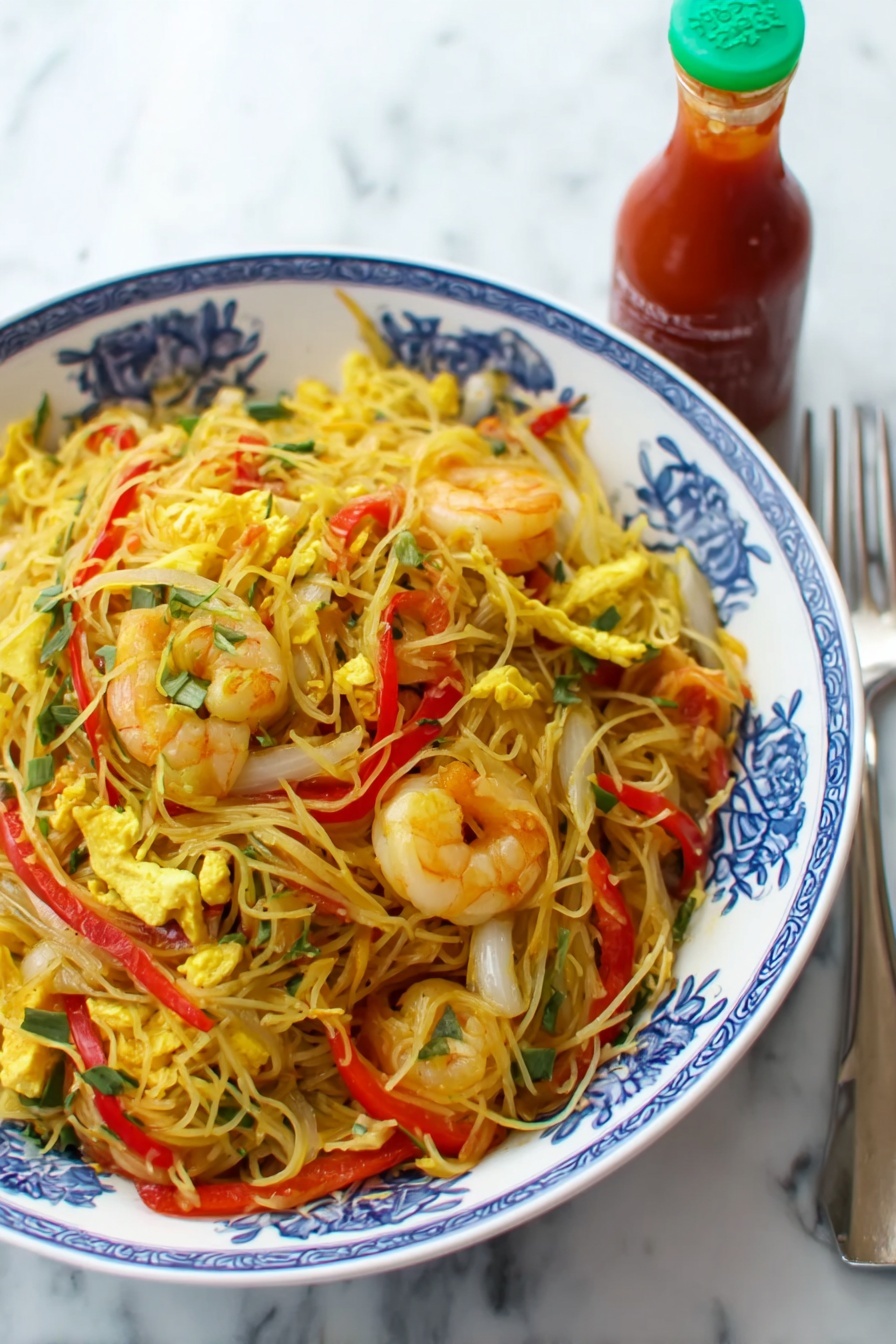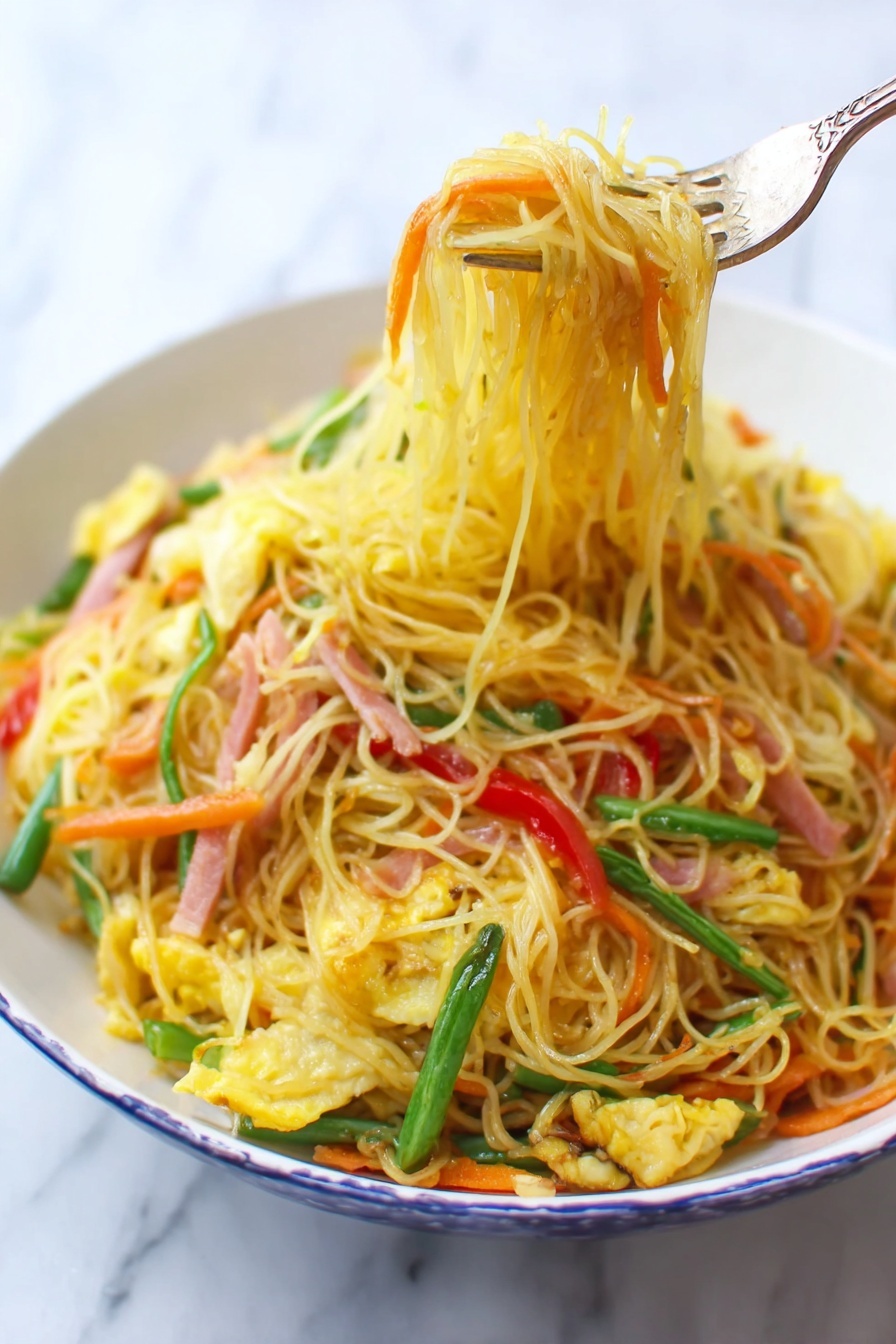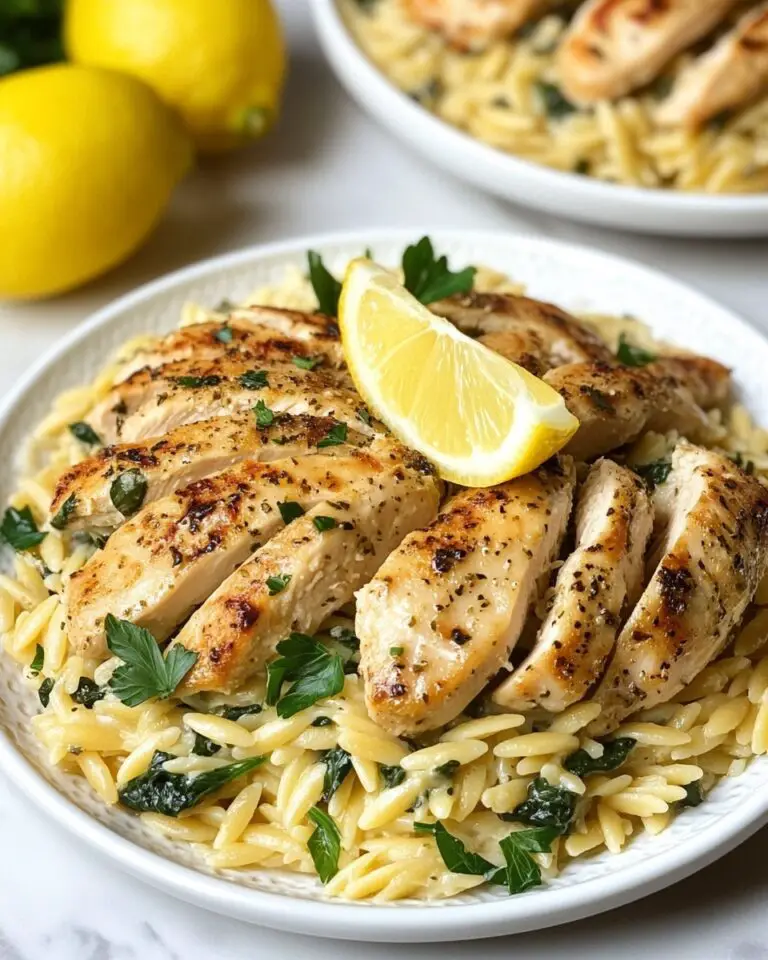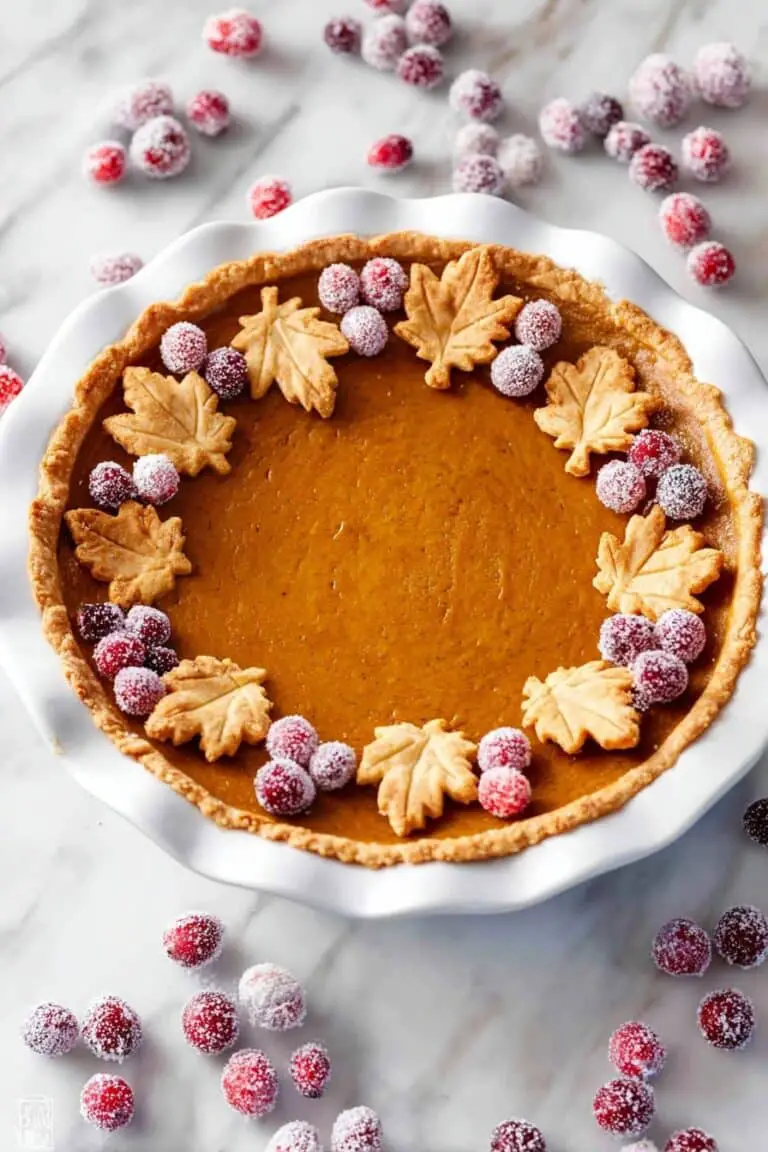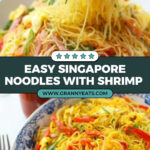If you love bold, vibrant flavors in your noodles, then you’re going to be crazy about this Singapore Rice Noodles with Shrimp and Curry Recipe. I absolutely adore how the curry powder adds a warm, aromatic kick that wakes up the whole dish, while the shrimp and colorful veggies keep it fresh and satisfying. Trust me, once you try this recipe, it’ll quickly become one of your weeknight go-tos or a fantastic crowd-pleaser when you want to impress friends without breaking a sweat.
Why You’ll Love This Recipe
- Bursting with Flavor: The curry powder and fish sauce blend creates an irresistible umami-packed taste.
- Quick and Easy: Ready in under 30 minutes, it’s perfect for busy nights without sacrificing taste.
- Versatile Ingredients: Customize with shrimp, pork, or vegetables you love to make it your own.
- Authentic Texture: Using kong moon-style rice noodles gives you that perfect chewiness and texture you want.
Ingredients You’ll Need
Getting the right ingredients is half the battle won. I always find that fresh shrimp and the right kind of rice noodles make a world of difference in this Singapore Rice Noodles with Shrimp and Curry Recipe. Plus, a good curry powder gives just the right punch—don’t worry, I’ll share tips on what works best!
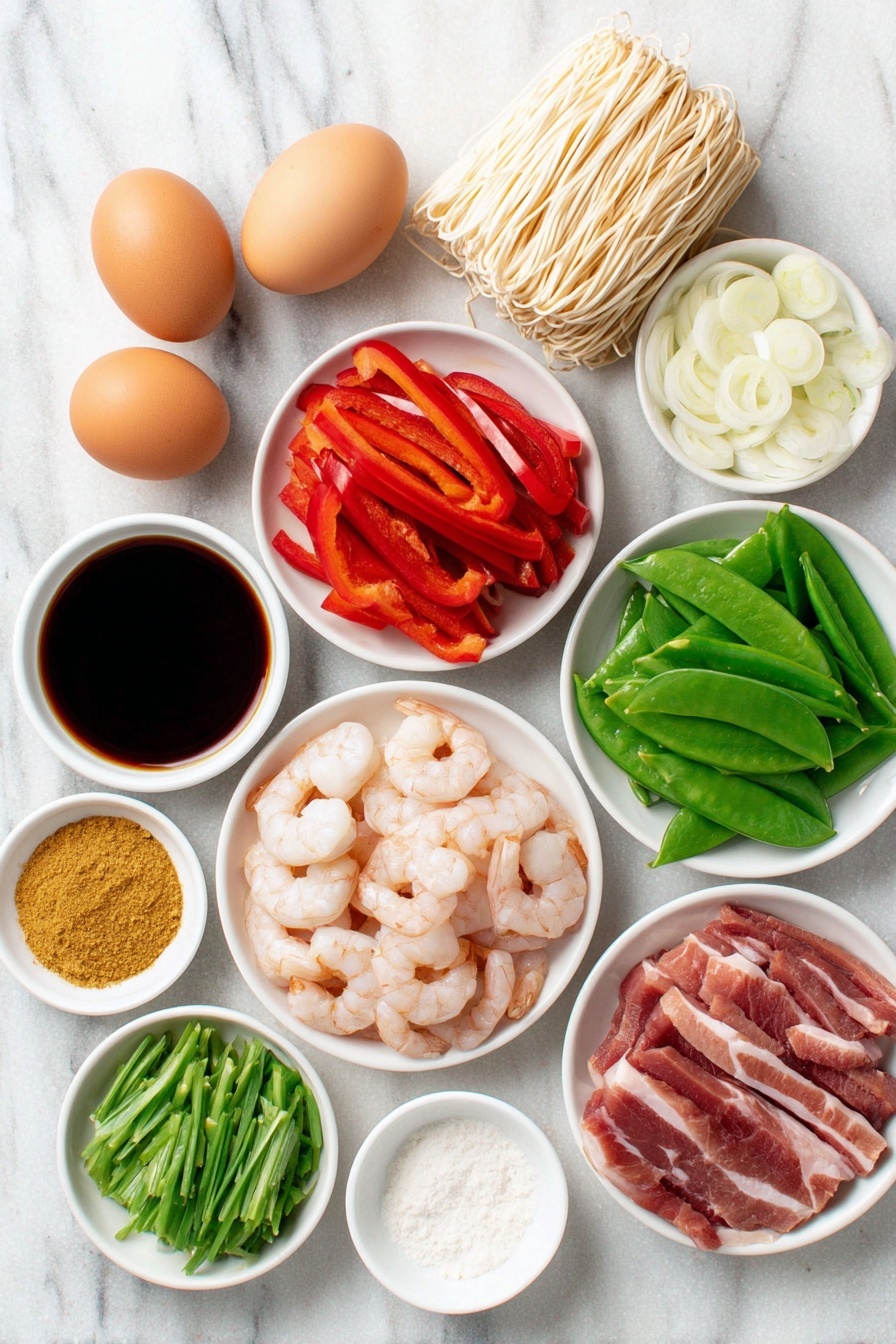
- Shrimp: Fresh or thawed shrimp work best; pat dry to get a good sear without steaming.
- Canola or vegetable oil: High smoke point oils help cook at high heat without burning.
- Asian fish sauce: Adds the classic umami saltiness essential to this dish’s flavor profile.
- Dried rice stick noodles (kong moon-style): Look for “kong moon” on the label for that authentic noodle texture.
- Garlic: Minced cloves pack a fragrant punch when stir-fried.
- Curry powder: I love using a Madras curry powder, but any good-quality curry powder does the trick.
- Soy sauce: Gives depth and balances the curry’s warmth.
- ShaoXing wine: This adds a subtle, slightly sweet finish – a nice touch if you have it.
- Ground white pepper: Offers a milder heat than black pepper, perfect for this dish.
- Sugar: Helps balance out the salty and spicy notes.
- Eggs: Beaten with salt, they add a comforting richness.
- Chinese roast pork (char siu) or ham: Thin slices bring in a smoky, savory flavor.
- Onion: Thinly sliced to soften quickly and blend into the stir-fry.
- Red bell pepper: Adds a sweet crunch and vibrant color.
- Snow peas: Fresh and crisp – slice thinly for best texture.
- Carrot: Julienned for a touch of sweetness and color contrast.
- Kosher salt: For seasoning to taste during the stir-fry.
- Scallions: Thinly sliced on the bias for a fresh finish.
- Toasted sesame oil: A final drizzle adds a nutty aroma that you’ll absolutely love.
Variations
One of the things I love about the Singapore Rice Noodles with Shrimp and Curry Recipe is how flexible it is. I switch up proteins or veggies depending on what’s in my fridge, which keeps it interesting and tailored to my cravings.
- Protein swap: If shrimp isn’t your thing, shredded chicken or tofu works wonderfully—just adjust the cooking time accordingly.
- Spice level: Add some chili flakes or fresh sliced chilies if you want more heat—my family loves it spicy.
- Vegetables: Feel free to add snap peas, baby bok choy, or mushrooms for extra texture and nutrients.
- Gluten-free option: This recipe is naturally gluten-free if you use tamari instead of soy sauce and double-check your curry powder ingredients.
How to Make Singapore Rice Noodles with Shrimp and Curry Recipe
Step 1: Marinate the Shrimp
Start by patting your shrimp dry with paper towels—this is key to getting a nice sear later on instead of steaming them. Toss them with a teaspoon of canola oil and half a teaspoon of fish sauce, then pop them in the fridge while you get everything else ready. I discovered this trick after many watery stir-fries; it really helps lock in flavor and keeps the shrimp juicy but not soggy.
Step 2: Soften the Rice Noodles
Place the dried rice stick noodles in a bowl and cover them with boiling water. Let them soak until they’re pliable—about 5 minutes or so. Then drain thoroughly and spread them out to dry on a wire rack over a tray; this prevents clumping when you stir-fry later. I like to cut the noodles in half with kitchen scissors here—it makes them easier to eat and easier to mix evenly in the wok.
Step 3: Prepare the Curry Sauce
In a small bowl, mix minced garlic with two teaspoons of curry powder, soy sauce, Shaoxing wine, white pepper, sugar, and the remaining two teaspoons of fish sauce. Thin it with a couple of teaspoons of water so the sauce spreads evenly over the noodles. This sauce is your flavor powerhouse—don’t skip this step, it’s what really brings everything together.
Step 4: Cook the Eggs
Heat a teaspoon of canola oil in your wok over high heat until it just starts to smoke, then pour in the beaten eggs with a pinch of kosher salt. Let them sit undisturbed for about 10 seconds before gently stirring. Break the eggs into small pieces once they’re nearly set, then transfer to a large bowl. You’ll want soft, fluffy pieces—not rubbery scrambled eggs. Wiping the wok clean afterward is my favorite little step to keep flavors bright and not mixed with any burnt bits.
Step 5: Stir-Fry Shrimp, Pork, and Vegetables
Back on high heat, add two tablespoons of oil, swirl it around, and toss in your marinated shrimp. Stir-fry for just 30 seconds—overcooking shrimp will make them rubbery. Next, add the roast pork and onion slices and stir for another 30 seconds. Then add red bell pepper, snow peas, and carrots, toss everything with the remaining teaspoon of curry powder, season with a pinch of salt, and cook until everything is beautifully coated and heated through. Transfer this to the bowl with your cooked eggs.
Step 6: Finish with Noodles and Sauce
Clean your wok one last time, heat the remaining two tablespoons of oil until smoking, then add the softened rice noodles. Stir-fry for about 30 seconds before stirring in the curry sauce you prepared. Use a little water, one or two teaspoons at a time, if needed, to help the sauce coat the noodles evenly. Then return the egg, shrimp, pork, and veggie mix to the wok, tossing everything for another 30 seconds. Finish by seasoning with salt to taste, adding the sliced scallions, and drizzling toasted sesame oil over the top before serving.
Pro Tips for Making Singapore Rice Noodles with Shrimp and Curry Recipe
- Pat Shrimp Dry: I learned this the hard way—wet shrimp steam instead of sear, so drying them ensures a better texture.
- Use Kong Moon Noodles: These give that authentic chew and don’t get mushy, which I discovered makes a huge difference in texture.
- Cook Veggies Last: Adding delicate veggies like snow peas and bell peppers towards the end keeps them crisp and colorful.
- Clean the Wok Between Steps: This prevents flavor buildup and burnt bits messing with the final dish’s bright flavors.
How to Serve Singapore Rice Noodles with Shrimp and Curry Recipe
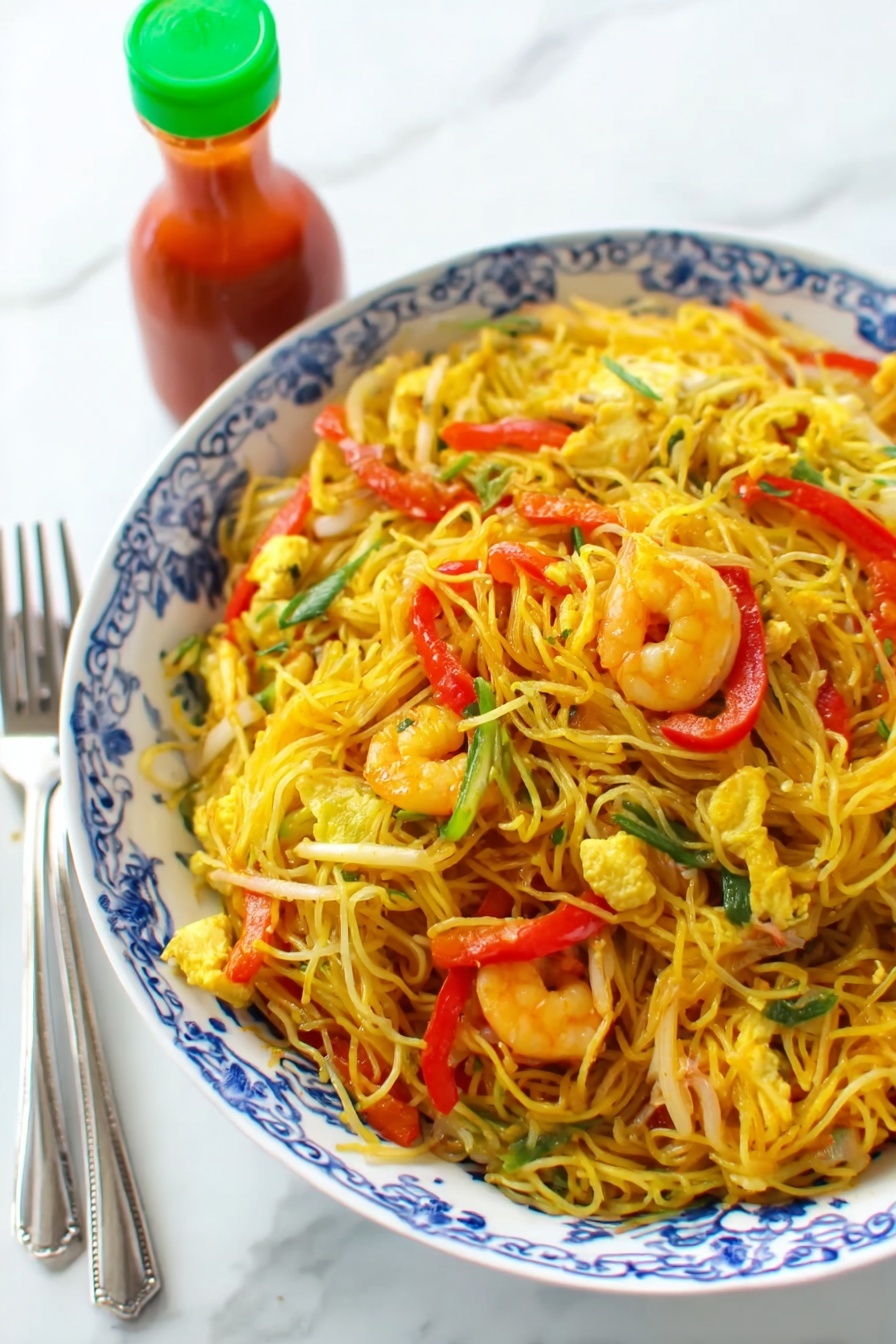
Garnishes
I love topping this dish with extra thinly sliced scallions and a sprinkle of toasted sesame seeds when I want a little extra texture and a fresh pop of color. Sometimes I also add a wedge of lime on the side for those who enjoy a little tang to brighten up the curry flavors.
Side Dishes
My go-to sides would be something light and crunchy like a simple cucumber salad or pickled vegetables to cut through the richness of the curry. Sometimes I serve it with some steamed bok choy or sautéed greens on the side for an easy, balanced meal.
Creative Ways to Present
For dinner parties, I like to serve Singapore Rice Noodles with Shrimp and Curry Recipe in individual bowls garnished with edible flowers and extra herbs for a stunning presentation. Passing around a bowl of chopped fresh cilantro and chili slices lets guests customize their heat and freshness levels, which always gets compliments.
Make Ahead and Storage
Storing Leftovers
I store any leftovers in an airtight container in the fridge and try to eat them within 2-3 days for best flavor and texture. The noodles hold up surprisingly well, though the veggies soften a bit, so I usually enjoy leftovers cold in a pinch or lightly reheat.
Freezing
Personally, I don’t recommend freezing Singapore Rice Noodles with Shrimp and Curry Recipe because the noodles can become mushy and the shrimp toughens when thawed. If you do freeze it, make sure to cool it completely and freeze in small portions, then reheat gently to preserve as much texture as possible.
Reheating
The best way I’ve found to reheat is to quickly toss leftovers in a hot skillet with a splash of water or broth to loosen the sauce and warm everything evenly without drying out the shrimp or noodles. Microwave works in a pinch, but tends to make the noodles stickier.
FAQs
-
What type of noodles should I use for Singapore Rice Noodles with Shrimp and Curry Recipe?
It’s best to use dried rice stick noodles labeled “kong moon” style, as they have the ideal texture and thickness that hold up well in stir-frying. Brands like Double Swallow are reliable choices. Avoid overly thin or fresh noodles as they can become mushy quickly.
-
Can I make this recipe vegetarian?
Absolutely! Simply skip the shrimp and roast pork, and swap in tofu or extra vegetables like mushrooms, bell peppers, and snap peas. Make sure to use vegetarian fish sauce or tamari to keep it vegetarian-friendly without losing flavor.
-
Is curry powder essential in this recipe?
Yes, the curry powder is what really defines this dish’s signature flavor. If you don’t have Madras curry powder, a quality mild curry powder from your local store works fine—just adjust the quantity to taste.
-
How do I prevent the noodles from sticking together?
After soaking the noodles, drain and spread them out on a wire rack to dry briefly before stir-frying. Cutting the noodles in half also helps prevent clumping. Stir-frying with sufficient oil over high heat further keeps them separated.
Final Thoughts
This Singapore Rice Noodles with Shrimp and Curry Recipe holds a special place in my kitchen because it’s one of those rare recipes that feels indulgent but comes together so easily. Every time I make it, my family can’t get enough, and I enjoy how adaptable it is when I need a quick, tasty meal that’s vibrant and satisfying. Give it a try—you’ll be amazed at how restaurant-quality your homemade noodles can be!
Print
Singapore Rice Noodles with Shrimp and Curry Recipe
- Prep Time: 10 mins
- Cook Time: 15 mins
- Total Time: 25 mins
- Yield: 4 servings
- Category: Main Course
- Method: Stovetop
- Cuisine: Singaporean
Description
Singapore Rice Noodles is a vibrant and flavorful stir-fried noodle dish featuring shrimp, Chinese roast pork, and a colorful mix of vegetables, all brought together with a fragrant curry powder sauce. This quick and delicious recipe offers a perfect balance of savory, spicy, and sweet notes for a satisfying meal.
Ingredients
Proteins
- 1/4 pound shrimp, shelled, deveined, and rinsed under cold water
- 1/4 pound Chinese roast pork (char siu) or ham, cut into thin strips
- 2 eggs, beaten with two pinches kosher salt
Vegetables
- 1/4 medium onion, very thinly sliced
- 1/2 medium red bell pepper, stemmed, seeded and julienned
- 12 snow peas, stemmed, tough strings removed, and sliced thinly on the bias
- 1/2 medium carrot, julienned
- 2 scallions, sliced very thinly on the bias
Noodles
- 1 bundle (about 5 1/2 ounces) dried rice stick noodles
Sauces and Oils
- 4 tablespoons plus 2 teaspoons canola or vegetable oil, divided
- 2 1/2 teaspoons Asian fish sauce, divided
- 1 teaspoon soy sauce
- 1 teaspoon Shaoxing wine
- 2 teaspoons toasted sesame oil
Spices and Seasonings
- 2 medium cloves garlic, minced
- 1 tablespoon curry powder, divided (see notes)
- 1/4 teaspoon ground white pepper
- 1/4 teaspoon sugar
- Kosher salt
Instructions
- Marinate Shrimp: Pat shrimp dry with paper towels and place in a small bowl. Add 1 teaspoon canola oil and 1/2 teaspoon fish sauce. Mix well and refrigerate to marinate.
- Prepare Noodles: Place rice noodles in a large bowl and cover with boiling water. Let stand until pliable, about 5 minutes. Drain noodles in a colander, then transfer to a rimmed baking sheet with a wire rack. Spread noodles evenly and cut them in half using scissors.
- Make Sauce: In a small bowl, combine minced garlic, 2 teaspoons curry powder, soy sauce, Shaoxing wine, white pepper, sugar, and remaining 2 teaspoons fish sauce. Mix well and thin with 2 teaspoons water. Set aside.
- Cook Eggs: Heat 1 teaspoon canola oil in a wok or nonstick skillet over high heat until smoking. Pour in beaten eggs and let cook undisturbed for about 10 seconds. Gently stir eggs until they start to firm. Break into small pieces and transfer to a large bowl.
- Stir-fry Shrimp and Vegetables: Wipe wok clean and return to high heat. Add 2 tablespoons oil and heat until smoking. Add marinated shrimp and stir-fry for 30 seconds. Add roast pork and onion; stir-fry another 30 seconds. Add red bell pepper and snow peas; stir for 30 seconds. Add carrots and remaining 1 teaspoon curry powder, season with salt, and toss until curry is evenly distributed. Transfer mixture to the bowl with eggs.
- Stir-fry Noodles: Clean wok again. Heat remaining 2 tablespoons canola oil over high heat until smoking. Add rice noodles and stir-fry for 30 seconds. Stir in sauce, adding 1-2 teaspoons water if needed to distribute evenly.
- Combine and Finalize: Return egg, shrimp, pork, and vegetables to wok. Stir-fry together for about 30 seconds until mixed well. Season with salt, remove from heat. Add sliced scallions and drizzle sesame oil over. Mix thoroughly and serve immediately.
Notes
- Look for rice noodles labeled ‘kong moon’ (also romanized as jiangmen) from Guangdong, China, for authentic texture; brands like Double Swallow are recommended.
- Madras curry powder from the brand Trong Food is suggested but any good quality curry powder from your local supermarket will work well.
Nutrition
- Serving Size: 1 serving (about 1/4 of the recipe)
- Calories: 380
- Sugar: 3g
- Sodium: 720mg
- Fat: 14g
- Saturated Fat: 3g
- Unsaturated Fat: 10g
- Trans Fat: 0g
- Carbohydrates: 45g
- Fiber: 3g
- Protein: 21g
- Cholesterol: 155mg

